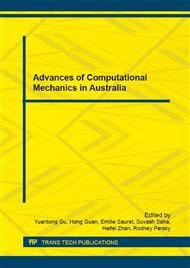p.288
p.294
p.300
p.306
p.312
p.318
p.325
p.331
p.336
A Review of Skin Buckling Theory in Composite Members
Abstract:
This paper provides a comprehensive review of various methods used for skin buckling analysis in composite components. The skin buckling phenomenon is one of the governing criteria in composite design. It is a kind of contact buckling in which partial sections of skin buckle away from the filler material. In general, the problem can be modelled as a thin plate (skin) in unilateral contact with elastic medium (filler material). The theoretical analysis of contact buckling is complicated due to the nonlinearity arising from changing contact regions. To simplify the calculations, the filler material was usually modelled as a tensionless elastic foundation. The skin buckling coefficient varies in terms of the relative foundation stiffness factors. Because the Eigen-value method is not applicable to nonlinear systems, the finite element (FE) method was usually employed for post-buckling analysis, while initial buckling performance was investigated through analytical or semi-analytical methods such as rigid foundation model, infinite plate model and finite plate model. The compressive buckling and shear buckling problems for thin plates resting on tensionless foundations have been solved successfully. However, there are still urgent needs for future research on the topic. For example, the load carrying capacity of the buckling plates needs to be formulated for practical application. Complicated problems with complex loadings and/or corrugated skins need further investigation as well.
Info:
Periodical:
Pages:
312-317
Citation:
Online since:
July 2016
Authors:
Price:
Сopyright:
© 2016 Trans Tech Publications Ltd. All Rights Reserved
Share:
Citation:


